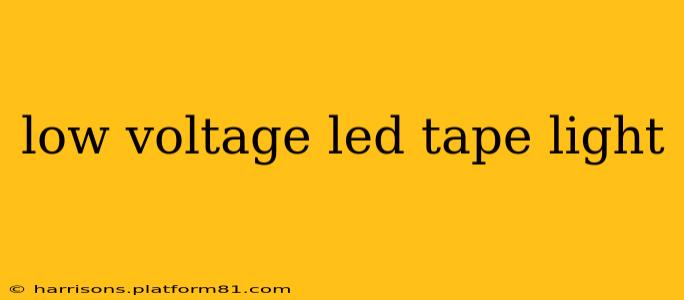Low voltage LED tape lights have revolutionized interior and exterior lighting design, offering a versatile, energy-efficient, and aesthetically pleasing solution for a wide range of applications. This comprehensive guide will delve into the specifics of low voltage LED tape lights, addressing common questions and providing valuable insights for both DIY enthusiasts and professionals.
What are Low Voltage LED Tape Lights?
Low voltage LED tape lights, also known as 12V LED strip lights, utilize light-emitting diodes (LEDs) mounted on a flexible circuit board. Unlike high-voltage alternatives, these lights operate on a lower voltage, typically 12 volts, requiring a power supply to step down the mains voltage (120V or 230V depending on your region). This lower voltage makes them safer and easier to install, especially in DIY projects. The flexible nature of the tape allows for creative applications, conforming to curves and edges with ease.
What are the Advantages of Low Voltage LED Tape Lights?
Low voltage LED tape lights offer a compelling array of advantages:
- Energy Efficiency: LEDs consume significantly less energy than traditional incandescent or halogen lighting, leading to lower electricity bills and a smaller carbon footprint.
- Long Lifespan: LEDs boast an exceptionally long lifespan, reducing the frequency of replacements and associated costs.
- Versatility: Their flexibility and adaptability make them suitable for various applications, from under-cabinet lighting to cove lighting, accent lighting, and even outdoor applications (with appropriate weatherproofing).
- Safety: The low voltage significantly reduces the risk of electric shock, making them safer to install and handle.
- Aesthetic Appeal: Low voltage LED tape lights offer a sleek, modern aesthetic, enhancing the visual appeal of any space.
- Dimmability: Many low voltage LED tape lights are dimmable, allowing for customized lighting levels to suit different moods and activities.
What is the difference between 12V and 24V LED strip lights?
The main difference between 12V and 24V LED strip lights lies in their voltage requirements and power supply needs. 24V systems generally offer advantages in longer runs (less voltage drop over distance) and higher power output, allowing for brighter illumination or longer strips without needing multiple power supplies. However, 12V systems are often more readily available and easier to work with for smaller projects. The choice depends on the project's scale and specific needs.
How to install Low Voltage LED Tape Lights?
Installing low voltage LED tape lights is relatively straightforward, but proper planning and execution are crucial. Key steps typically involve:
- Planning the Layout: Measure the area and plan the placement of the lights, considering power supply placement and accessibility.
- Preparing the Surface: Ensure the surface is clean, dry, and free of debris.
- Cutting the Tape: LED tape lights can be cut at designated points to adjust the length.
- Connecting the Power Supply: Connect the LED tape to the appropriate power supply.
- Mounting the Tape: Use adhesive backing or clips to secure the tape to the desired surface.
- Connecting Controllers (if applicable): Connect any controllers, such as dimmers or RGB controllers.
- Testing the Installation: Thoroughly test the installation to ensure everything is functioning correctly.
How much does low voltage LED tape lighting cost?
The cost of low voltage LED tape lighting varies depending on several factors, including the length of the strip, the type of LEDs (e.g., RGB, single color), the features (e.g., dimmability), and the brand. Generally, you can expect to pay a reasonable price per foot, making it a cost-effective lighting solution in the long run.
Are Low Voltage LED Tape Lights suitable for outdoor use?
While many low voltage LED tape lights are designed for indoor use, there are also waterproof and weatherproof options explicitly designed for outdoor applications. These typically have an IP rating (Ingress Protection rating) indicating their level of protection against dust and water. For outdoor use, always choose lights with a suitable IP rating to ensure longevity and safety.
What are the different types of Low Voltage LED Tape Lights?
Low voltage LED tape lights come in various types, including:
- Single-color LED strips: These offer a single color of light, such as warm white, cool white, or a specific color.
- RGB LED strips: These strips contain red, green, and blue LEDs, allowing for a wide range of color options through color mixing.
- RGBW LED strips: These add a white LED to the RGB configuration, providing greater control and flexibility in color temperature and brightness.
- Addressable LED strips (e.g., WS2812B): These allow for individual control of each LED, enabling advanced lighting effects and animations.
By understanding the nuances of low voltage LED tape lights and addressing specific concerns, you can make an informed decision that suits your needs and budget. Remember to always consult with a qualified electrician for complex installations or if you are unsure about any aspect of the process.
